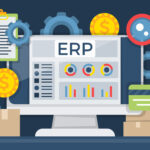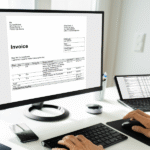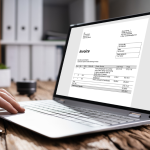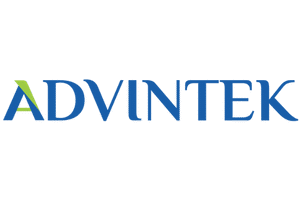Malaysia is making significant strides in digitizing its financial ecosystem, with e-invoicing at the forefront of this transformation. This government-driven initiative aims to simplify tax compliance, enhance transparency, and foster seamless B2B, B2C, and B2G transactions. While promising, the process introduces complexities, particularly for businesses venturing into e-invoicing for the first time.
This guide offers an in-depth look at Malaysia’s e-invoicing landscape, outlining step-by-step instructions to submit, validate, and issue e-invoices, ensuring businesses can navigate this transition effortlessly.
What Is e-Invoicing in Malaysia?
E-invoicing is a structured approach to invoicing, where digital invoices pass through the Inland Revenue Board of Malaysia (IRBM) for validation and compliance before final issuance. Each e-invoice contains crucial components like a Unique Identification Number (UIN) and a QR code to ensure traceability and authenticity.
This move not only aligns Malaysia with global best practices but also ensures tax data accuracy and reduces opportunities for tax evasion.
Who Needs to Comply with e-Invoicing?
Malaysia’s e-invoicing rollout is phased, with compliance deadlines based on business turnover:
- Phase 1 (August 1, 2024): Businesses with revenue exceeding RM 100 million.
- Subsequent phases will include smaller businesses over time.
Compliance is mandatory for B2B, B2C, and B2G transactions, making it imperative for businesses to adapt promptly.
e-Invoicing Models in Malaysia
1. MyInvois Portal
Designed for micro, small, and medium enterprises (MSMEs), the MyInvois portal provides a straightforward interface for manual entry and batch uploads. This option is ideal for businesses with limited transaction volumes or technological resources.
2. API Integration with MyInvois
Larger enterprises benefit from API integrations that link ERP, POS, or billing systems directly with the MyInvois system. This approach automates data exchange and enables real-time e-invoice generation. Middleware providers play a critical role in facilitating this integration.
Step-by-Step Guide to e-Invoicing in Malaysia
Step 1: Submission
- Generate an invoice in the prescribed format using the MyInvois portal or API.
- Include all required details, such as buyer and supplier information, transaction values, and tax codes.
Step 2: Validation by IRBM
- The IRBM system checks for errors, ensuring compliance with formats and mandatory fields like TIN and MCIR.
- Upon successful validation, a UIN and QR code are generated.
Step 3: Notification
- Notifications about validation results are shared with both suppliers and buyers. API users receive automated alerts, while MyInvois portal users receive email updates.
Step 4: Sharing the e-Invoice
- Approved e-invoices, embedded with QR codes, are sent to buyers for their records.
Step 5: Cancellation or Rejection
- Both parties have a 72-hour window to reject or cancel a validated e-invoice.
- Beyond this timeframe, the invoice is deemed accepted, with amendments requiring new documents like credit or debit notes.
Step 6: Recordkeeping
- E-invoices are stored in IRBM’s database, but businesses must maintain records for audit and compliance.
Step 7: Reporting and Analytics
- Users can access dashboards for data retrieval and analysis, enabling better financial insights.
Special Provisions for B2C Transactions
When Buyers Require an e-Invoice
The seller collects customer details, processes them through MyInvois, and shares the validated e-invoice with the buyer.
When Buyers Do Not Require an e-Invoice
- Sellers issue regular receipts for transactions.
- At the month’s end, sellers consolidate these receipts into a single e-invoice and submit it to IRBM.
- Middleware systems can streamline this process for efficiency.
Leveraging Middleware for Seamless Integration
Middleware solutions bridge the gap between a business’s ERP systems and the MyInvois platform, offering:
- Batch Processing: Simplifies handling large volumes of transactions.
- Error Reduction: Automates validation, minimizing manual errors.
- Real-Time Reporting: Ensures timely compliance and data accuracy.
Advintek specializes in providing tailored middleware solutions to meet diverse business needs.
Advantages of e-Invoicing
- Enhanced Transparency: Every transaction is traceable, reducing disputes and errors.
- Streamlined Tax Compliance: Automated validation ensures adherence to regulations.
- Operational Efficiency: API integrations and middleware eliminate redundant processes.
- Cost Savings: Reduced paperwork and manual intervention translate into financial benefits.
Conclusion: Advintek – Your Partner in Digital Transformation
Navigating Malaysia’s e-invoicing mandate may seem daunting, but with the right approach and technology, businesses can achieve seamless compliance. Whether you’re a large enterprise exploring API integrations or an SME relying on manual uploads, Advintek is here to simplify the journey.
As an ISO27001-certified and Peppol-accredited Access Point Provider, Advintek ensures robust, secure, and efficient e-invoicing solutions tailored to your needs. Trust us to be your partner in embracing the future of financial transactions in Malaysia.
Contact Advintek today to streamline your e-invoicing process and stay ahead in the digital economy.









